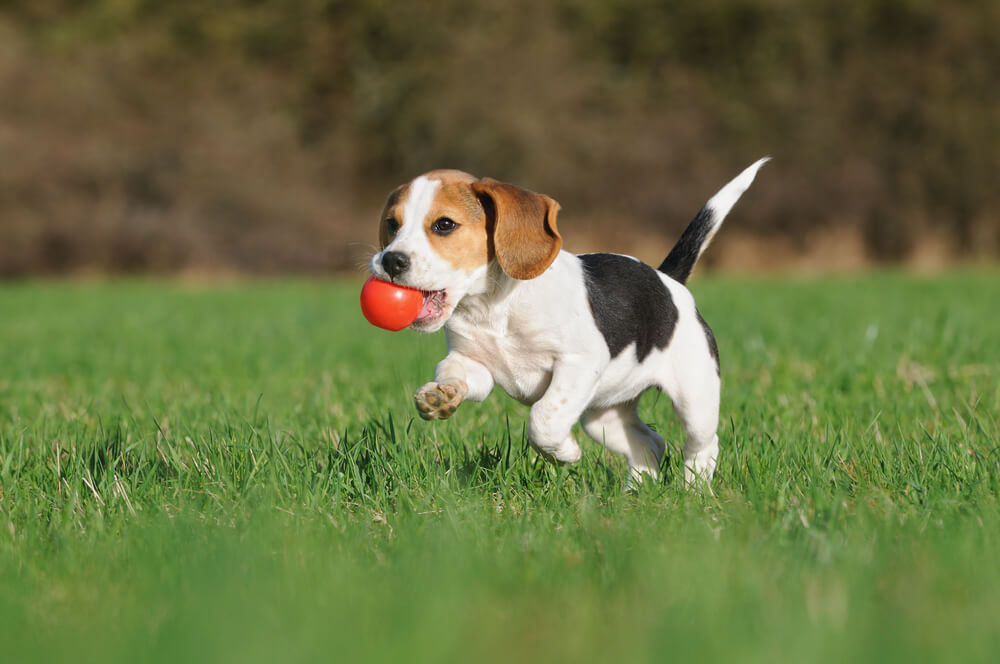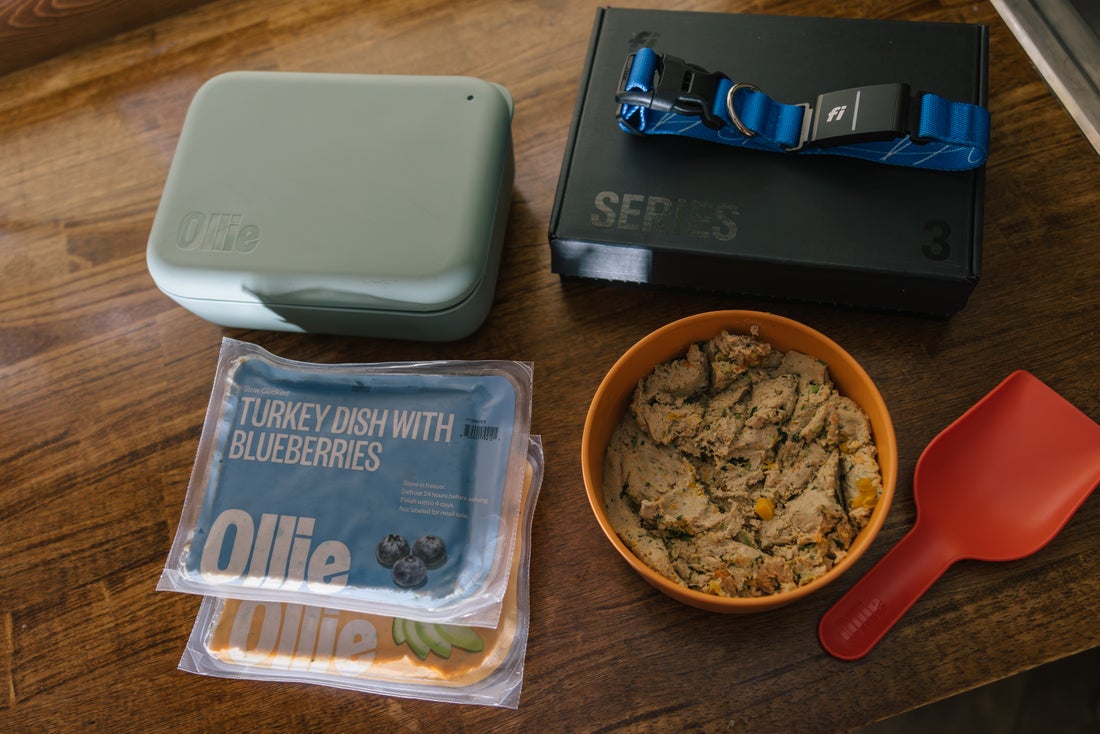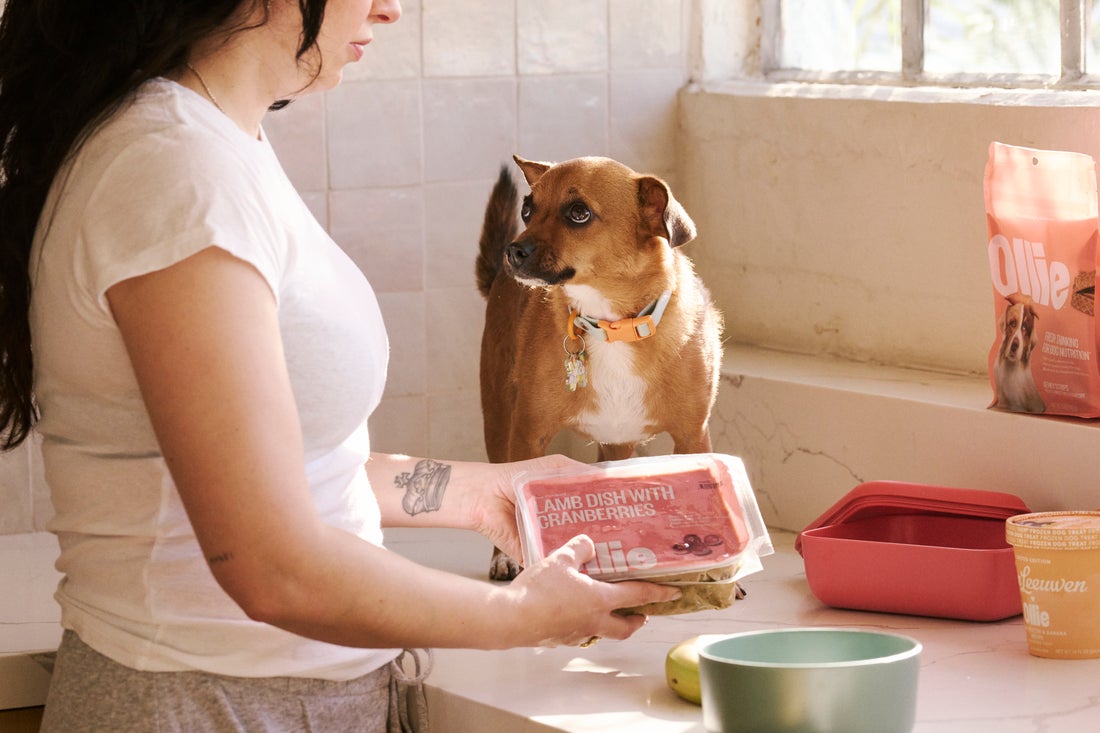Hey Ollie blog readers! We’re offering you an exclusive 60% OFF your starter box! Try now!
Noticing blood in your dog’s stool can be unsettling—but it’s more common than you might think. Whether it’s bright red streaks or darker, tarry poop, this symptom often signals something wrong in your dog’s digestive tract. In some cases, it’s caused by something minor like a dietary change. In others, it could be a sign of infection, inflammation, or something more serious.
The most important first step? Call your veterinarian. Even if your dog seems otherwise fine, a quick call can help determine whether it’s an emergency or something to monitor at home. Take note of the color, consistency, and frequency of the bloody stool, and if possible, collect a sample. This information will help your vet pinpoint the cause and decide on next steps.
In this guide, we’ll walk you through:
- The possible causes of blood in dog poop
- When to call the vet—and what to expect
- What blood in dog stool might look like
- How diet and lifestyle can play a role in prevention
Let’s break it down so you feel confident and prepared to help your pup.
Why Is My Dog Pooping Blood?
Finding blood in your dog’s stool can be scary—but it’s a symptom, not a diagnosis. Blood in dog poop can happen for many reasons, ranging from minor issues like dietary changes to serious conditions like infections or internal bleeding. The color and texture of the blood offer important clues about what’s going on inside your dog’s body.
There are two main types of bloody stool in dogs:
- Hematochezia – Bright red blood, often on or around the surface of your dog’s poop
- Melena – Dark, tarry stool that indicates digested blood from higher up in the digestive tract
Understanding the difference can help your vet figure out the source and urgency of the issue.
Causes of Bright Red Blood in Dog Poop (Hematochezia)
When you see bright red streaks or spots in your dog’s stool, the bleeding is likely coming from the lower gastrointestinal (GI) tract—like the colon or rectum. Common causes include:
- Parvovirus (Parvo): A dangerous and highly contagious virus, especially in puppies. It causes severe GI symptoms and can be fatal without treatment.
- Colitis: Inflammation of the colon, often caused by stress, bacteria, or parasites.
- Diet changes or food intolerance: Switching foods too quickly, overfeeding, or giving too many rich treats can trigger inflammation and bleeding.
- Stress-related bleeding: Major life changes, new environments, or separation anxiety can lead to digestive upset and bloody stools.
- Rectal injury: Scratches, trauma, or inflammation near the anus can cause bleeding during bowel movements.
- Toxin ingestion: Some garden plants, pesticides, or human foods can damage the GI tract.
- Anal gland issues: Infections or impactions in the anal glands can rupture or bleed.
- Hemorrhagic Gastroenteritis (HGE or AHDS): A rapid-onset condition that causes vomiting and bloody diarrhea—considered an emergency.
Expert Note: If your dog is a puppy, unvaccinated, or showing additional signs like vomiting or lethargy, contact your vet immediately.
Causes of Dark, Tarry Blood in Dog Poop (Melena)
Dark red or black, sticky stool usually means the bleeding is coming from the upper GI tract—like the stomach or small intestine—and the blood has been digested before being passed. This is often more serious than hematochezia.
Common causes include:
- Non-steroidal anti-inflammatory drugs (NSAIDs): Medications like aspirin can cause internal bleeding as a side effect.
- Ulcers in the stomach or intestines: Often triggered by stress, medications, or underlying disease.
- Tumors: Bleeding growths in the digestive tract or mouth.
- Parasites: Hookworms, whipworms, and other intestinal parasites can cause chronic bleeding and anemia.
- Foreign objects: Swallowed items like bones or toys can cause internal tears.
- Liver or kidney disease: Organ dysfunction can lead to blood clotting issues and GI bleeding.
- Pancreatitis: Inflammation of the pancreas, often tied to fatty meals or underlying conditions.
- Hormonal imbalances: Conditions like Addison’s disease can lead to GI complications.
- Congenital bleeding disorders: Such as von Willebrand’s Disease, which affects the blood’s ability to clot.
Expert Note: Melena is often a sign of a more serious internal issue. If your dog’s stool looks tar-like or smells unusually foul, get veterinary help right away.
Blood in your dog’s stool—whether bright red or dark and sticky—should never be ignored. While some causes are mild and treatable, others can escalate quickly without proper care. The best course of action is to collect a stool sample, note any other symptoms (vomiting, diarrhea, lethargy), and contact your veterinarian for guidance.
Early action can make all the difference in protecting your dog’s health.
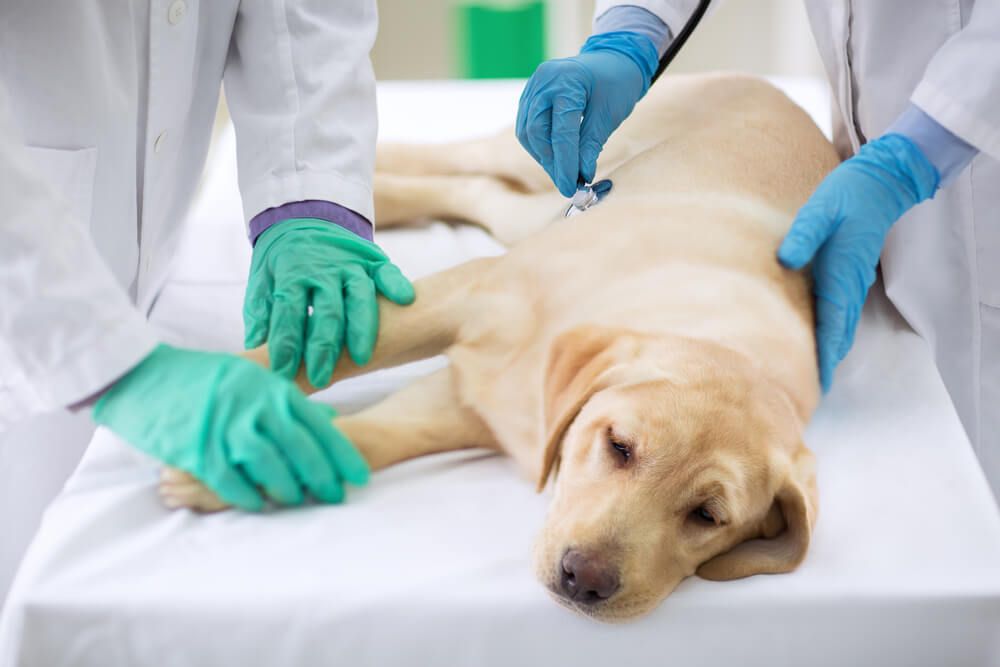
Take note of the color and the consistency of the stool so you can share this with the doctor. If possible, it’s best to collect a sample in case the vet wants to see your pup and test the stool. The doctor’s office will tell you how to collect a sample so you can bring it to your appointment. The stool sample may need to be examined and tested so the doctor can determine the source and cause of the bleeding.
What Does Blood in Dog Stool Look Like?
Spotting blood in your dog’s poop can be alarming—and understanding what you’re seeing can help determine how serious it might be. Blood in a dog’s stool generally falls into two categories, and the difference comes down to color and texture.
Bright Red Blood (Hematochezia)
If you notice bright red streaks or spots on or around your dog’s stool, this is known as hematochezia. It usually indicates that the bleeding is coming from the lower part of the digestive tract—such as the colon or rectum.
This type of blood is:
- Often fresh and visible on the outside of the poop
- Sometimes mixed into loose stools or diarrhea
- More noticeable if your dog strains to poop
Even if your dog’s behavior seems normal, bright red blood in the stool is not something to ignore. It could be caused by inflammation, infection, parasites, or even a minor rectal injury—but it should still be discussed with your vet.
Dark, Tarry Stool (Melena)
Stool that appears black, shiny, or tar-like is called melena, and it suggests the presence of digested blood from the upper digestive tract (such as the stomach or small intestine). This type of bleeding is typically more serious.
Signs of melena include:
- Very dark or black stools
- Sticky or shiny consistency
- Strong, unusually foul odor
Because this blood has been partially digested, it may not look like “blood” at first glance. One way to check is to blot the stool with a white paper towel—if there’s a reddish or brownish tinge, it could be melena.
Expert Note: If you’re unsure whether what you’re seeing is blood, it’s always safest to call your vet. A quick phone consultation can help determine if your dog needs to be seen right away.
What Should I Do If My Dog Has Bloody Stool?
Try really hard not to panic. But, whether your dog’s bloody poop is red or black, it’s important to call your vet as soon as possible. The cause of blood in dog’s stool can be as benign as a little bit of stress, or as serious as Parvo which is why it’s important to rule out more serious issues to keep your dog happy and healthy! Getting treatment for a more serious issue quickly increases the chance of a positive outcome, so don’t wait.

How should I prepare for a doctor’s appointment and what can I expect?
When you call the doctor’s office, the receptionist or tech may ask you a few questions to see if they can determine the issue and its severity. These questions might be about any changes to your pup’s energy level, diet or any other symptoms you’re noticing. They might also ask if any of your pup’s toys are missing or if they might have gotten into anything they shouldn’t have. Answer as honestly as you can, these questions aren’t to pass judgment but to try to quickly figure out what might be causing your dog’s distress.
If the receptionist or tech tells you that you need to bring your pup in, try to get them to the vet as quickly as possible. If you aren’t going right to the doctor, ask about whether you should allow your dog to eat or drink prior to the appointment.
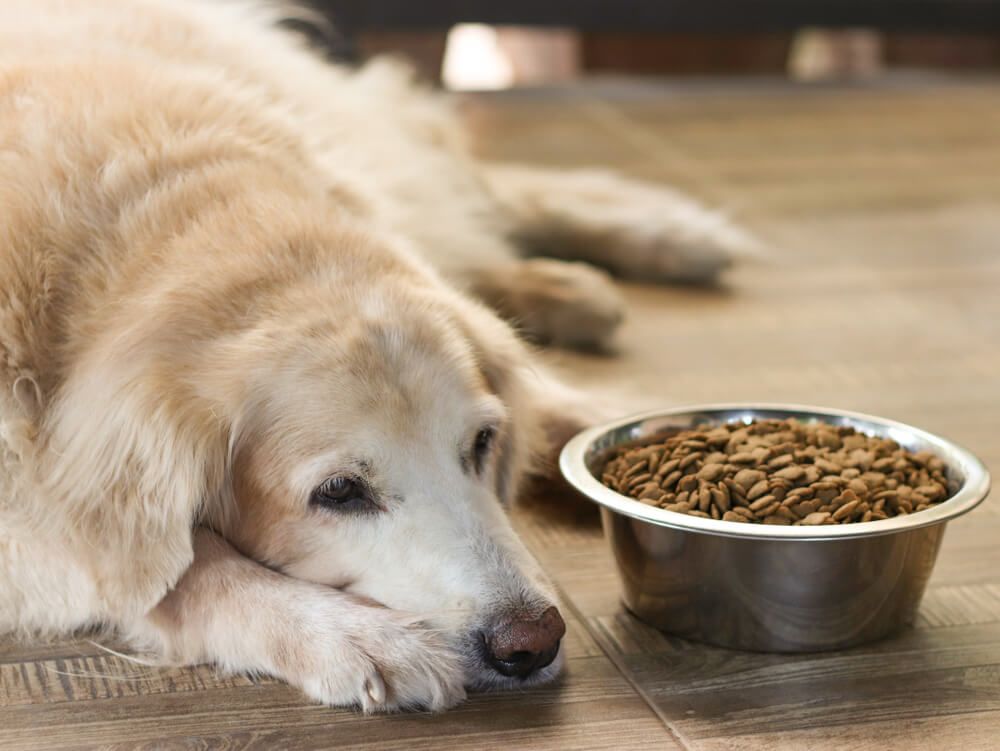
Also, keep an eye on your dog’s bowel movements. If your pup goes to the bathroom again, collect the sample and let your vet know how often your dog has been going, especially if it is more or less frequent than normal.
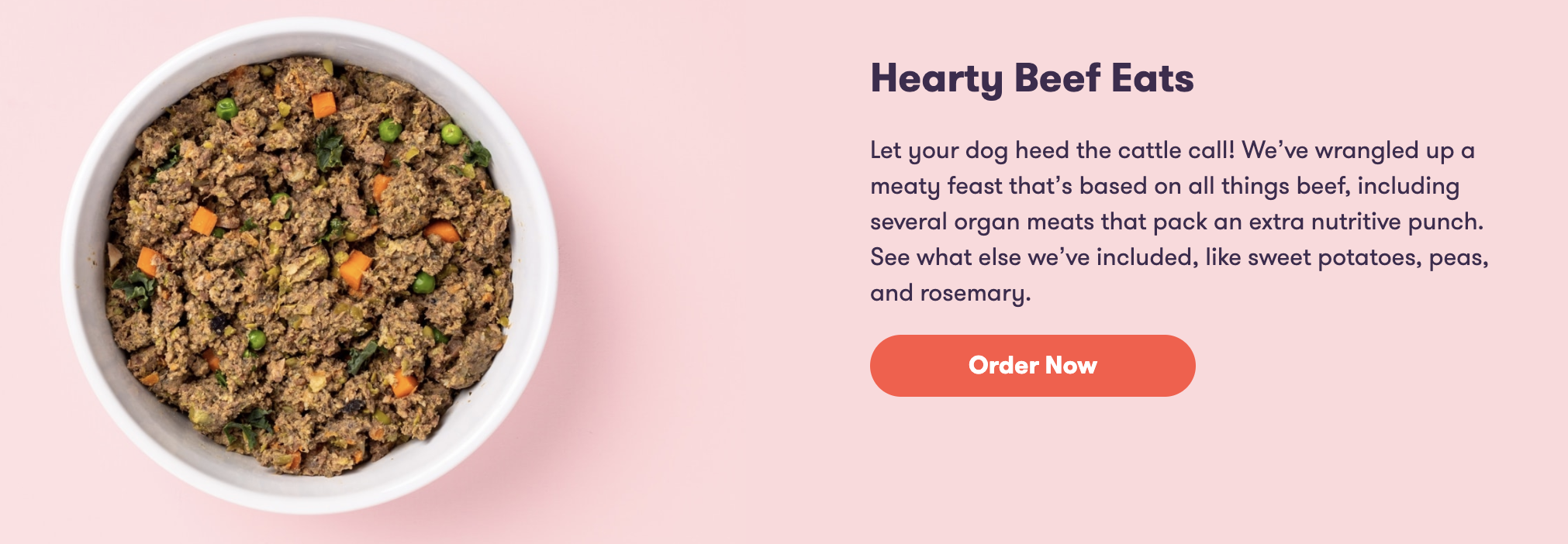
Your vet will take your pup’s vitals (temperature, heart rate etc.) and a quick history. You may find yourself telling the doctor what you have already told the tech, but this information is really important so keep repeating yourself when you’re asked.
The vet will then perform a physical exam and feel your pup’s belly to check for anything abnormal. Your pet may also get an ultrasound or X-ray so the vet can get a better look at what is going on. Communicate with your vet throughout this process, it is okay to ask about the cost of these procedures and find out if they are covered by insurance if your pet has it.
Once the vet is able to make a diagnosis or at least a suspected diagnosis, they will be able to discuss a recommended treatment plan. Follow your vet’s directions carefully and make any dietary modifications and give any medicine as directed.
If your pet has any side effects or seems to be getting worse, contact your vet’s office immediately. A sick pet can be scary and stressful for both of you. Hopefully, your pet is able to feel better quickly!
FAQ About Dogs Pooping Blood
Why is my dog pooping blood but acting normal?
Even if your dog seems fine, blood in the stool can signal underlying issues like colitis, parasites, or dietary irritation. Some problems may not show symptoms right away, so it’s best to contact your vet—even if your dog appears otherwise healthy.
Is bright red blood in dog poop serious?
Bright red blood (called hematochezia) often comes from the lower digestive tract. It can be caused by minor issues like stress or food changes, but it could also mean infection or injury. It’s important to have a vet rule out anything serious.
What should I do if my dog has bloody diarrhea?
If your dog has diarrhea with blood—especially if they’re vomiting, lethargic, or not eating—call your vet immediately. Dehydration and internal issues can progress quickly in dogs.
Can something my dog ate cause bloody stool?
Yes. Sudden diet changes, spoiled food, bones, or toxins (like certain plants or human medications) can irritate the GI tract and lead to bloody stools. Always monitor what your dog has access to, indoors and outside.
When should I take my dog to the vet for blood in their stool?
Call your vet if:
- You see blood more than once
- It’s combined with vomiting or diarrhea
- Your dog is very young, old, or has other health issues
- The stool is black and tarry (melena)
- You’re unsure and just want peace of mind
The Ollie blog is devoted to helping pet parents lead healthier lives with their pups. If you want to learn more about our fresh, human-grade food, check out MyOllie.com.
Tagged As:

The nutrition your dog needs,
the food they want.

Enjoying our articles? Subscribe our Newsletters and get new articles directly to your inbox
You might also like
18 September 2025
5 MINS READ
Can I Rotate Fresh Dog Food Flavors?
Yes, it’s safe to rotate fresh dog food flavors, and many dogs actually benefit from the variety. At Ollie, we offer multiple fresh recipes, like Beef, Chicken, Turkey, Lamb, and Pork so you can…
by Ollie Pets
18 September 2025
5 MINS READ
Is Fresh Dog Food Safe During Power Outages?
Fresh dog food is only safe during a power outage if it has stayed cold, specifically, below 40°F. Once the temperature rises above that point, bacteria can start to grow, and the food may no lon…
by Ollie Pets
18 September 2025
5 MINS READ
How Do I Store Fresh Dog Food While Traveling?
If you’re bringing fresh dog food on the road, keeping it cold is key. The best way to store it is in a cooler with ice packs or a travel freezer. At Ollie, our vacuum-sealed fresh food stays good…
by Ollie Pets


